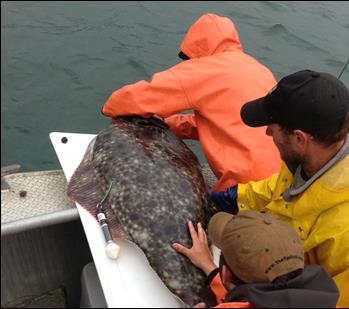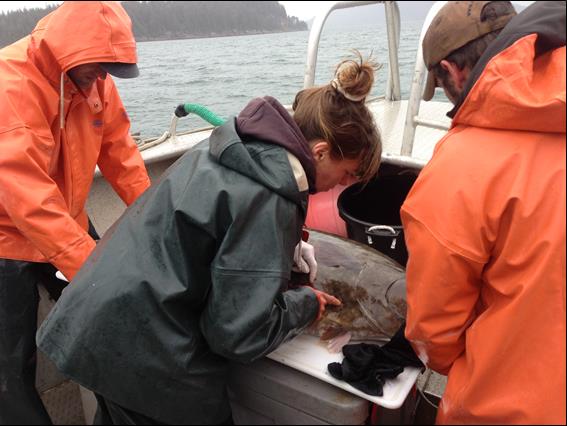Do halibut leave Glacier Bay to spawn elsewhere in winter? If they do leave, do they ever return?
Project Dates
June 2013 - December 2015
Did You Know?
The record for the longest Pacific halibut migration is held by a fish tagged near Atka Island in the Aleutian Islands and recaptured at Coos Bay, Oregon, a distance of 2,500 miles.
Introduction

In 1999 Congress passed legislation to phase out all commercial fisheries (not including charter sport fishing) in Glacier Bay proper. Commercial fishing is now restricted to about 100 individual fishermen who hold lifetime access permits. As these fishermen retire, all commercial fishing in the bay will cease sometime between 2050 and 2060. At that time, Glacier Bay will be the largest marine area in Alaska that is off-limits to commercial fishing. Also, Glacier Bay National Park was designated a Marine Protected Area (MPA) in 2009, and thus has joined a nationwide system of MPAs designed to advance marine conservation and sustainable use.
How will the abundance of Pacific halibut in Glacier Bay be affected by the end of the commercial fishery? In part this may depend on whether and when halibut stay in the protected waters or migrate out to unprotected areas.
Typically, halibut occupy inshore feeding areas such as Glacier Bay during the summer, migrate offshore to the deep waters of the continental slope in the Gulf of Alaska to spawn during the winter, and then return to summer feeding areas in the spring. Current regulations prohibit fishing during the winter spawning season, but Glacier Bay fish could be vulnerable (even after the mid-century closure) to commercial fishing outside bay waters in the spring and fall, depending on the timing of their migrations.
The goal of this study is to assess the effectiveness of Glacier Bay as a Marine Protected Area for Pacific halibut by examining the seasonal movements of individual fish out of and into the Bay. Using electronic tags, the researchers will track halibut movements and gather information on the proportion of fish that leave the bay in winter, the timing and temporal extent of migrations, and the proportion of fish that return to the bay the next summer.
Methods

Twenty-five adult Pacific halibut were caught in Glacier Bay in July 2013 using commercial long-line fishing gear, fitted with satellite tags (and, in some cases, acoustic transmitters), and released. Because satellite transmission is not possible from the ocean depths, “pop-up” tags were used. These tags collect and store data. At a predetermined time, the tag releases from the fish and transmits stored information to satellites upon reaching the ocean surface. All tags will measure and record daily summaries for ambient water temperature, depth, and light intensity; 15 of the tags will also measure magnetic field strength and acceleration. These data will be used to help reconstruct the halibuts’ movements, since a GPS cannot be used at depth.
Fifteen of the tags are programmed to release from the fish during the peak of the spawning season in early February, and ten tags are programmed to release one year after deployment (early summer 2014). When the tag reaches the ocean surface, an accurate location can be obtained by the satellites and, with luck, the tag can be retrieved. Even if the tag is not retrieved, daily summary information will be obtained, as well as the approximate location of the halibut at the moment the tag released. The data will be used to estimate the migration patterns of the tagged halibut.
Some of the fish were double-tagged with surgically-implanted acoustic transmitters. These tags emit an acoustic signal that can be tracked from a boat if the boat is within 200—500 meters. The researchers returned bi-weekly for two months to locate the fish. This will provide independent verification of fish locations and magnetic field measurement accuracy recorded by the pop-up satellite tags while the tagged fish are in Glacier Bay. This information will also be valuable for identifying summer foraging behavior, feeding locations, and small scale site fidelity during summer.
Learn More
International Pacific Halibut Commission http://www.iphc.int/home.html
Last updated: September 15, 2016
